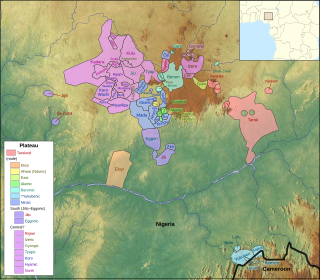Related Research Articles

The Chadic languages form a branch of the Afroasiatic language family. They are spoken in parts of the Sahel. They include 150 languages spoken across northern Nigeria, southern Niger, southern Chad, the Central African Republic, and northern Cameroon. The most widely spoken Chadic language is Hausa, a lingua franca of much of inland Eastern West Africa.

The forty or so Plateau languages are a tentative group of Benue–Congo languages spoken by 15 million people on the Jos Plateau, Southern Kaduna, Nasarawa State and in adjacent areas in central Nigeria.
Tarok is an agrarian society in the hills and on the plains southeast of Plateau State, Middle Belt, Nigeria.

There are over 525 native languages spoken in Nigeria. The official language and most widely spoken lingua franca is English, which was the language of Colonial Nigeria. Nigerian Pidgin – an English-based creole – is spoken by 30 million people in Nigeria.

The West Chadic languages of the Afro-Asiatic family are spoken principally in Niger and Nigeria. They include Hausa, the most populous Chadic language and a major language of West Africa.
Chakato is a West Chadic language spoken in Plateau State, Nigeria. It was identified by Roger Blench in 2016. It is spoken by about 500 people in one village, Dokan Tofa, which is located on the Jos-Shendam road in Plateau State. Blench (2017) suggests that Chakato may be related to spurious records of the Jorto language. Chakato speakers claim that their language is closely related to Goemai.

Ngas, or Angas, is an Afro-Asiatic language spoken in Plateau State, Nigeria. The language has two dialects: Hill Angas and Plain Angas. Retired General Yakubu Gowon is a prominent Nigerian who is of Ngas extraction.

The Angas, Angas–Sura, or Central West Chadic languages are a branch of West Chadic languages spoken in Plateau State, north-central Nigeria.
The five Tarokoid languages are a branch of the Plateau family spoken in central Nigeria, just north of the middle reaches of the Benue River. Tarok itself has 300,000 speakers, with Pe and Sur about 5,000 each. Yangkam is severely endangered, being spoken by around fifty elderly men.
Alumu is a Plateau language spoken by approximately 7,000 people in Nassarawa State, Nigeria. It has lost the nominal affix system characteristic of the Niger–Congo family.
Yiwom (Ywom), also known as Gerka or Gerkawa by the Hausa, is a Chadic (Afro-Asiatic) language spoken in Plateau State, Nigeria.
Hasha, also known as Yashi, is a Plateau language of Nasarawa State Nigeria. It has an idiosyncratic system of reduplicating the first syllable of noun stems, apparently under the influence of the Chadic language Sha.
The Rigwe language, Nkarigwe, is a Plateau language of Nigeria spoken by the Irigwe people mainly found in Bassa Local Government Area of Plateau State.
Pe, also spelled Pai, is a minor Plateau language of Nigeria. It has been classified in various branches of Plateau, but is now seen to be Tarokoid.
Yankam (Yangkam), or Bashar (Basherawa), is a moribund Plateau language of Nigeria. It is located to the west of Bashar town in Plateau State.

The Ron, Ronic or Ron–Fyer languages, group A.4 of the West Chadic branch of the Afro-Asiatic language family, are spoken in Plateau State, north-central Nigeria.
Jibyal is a West Chadic language spoken in Plateau State, Nigeria. It was discovered by Roger Blench in 2017.
Nteng is a West Chadic language spoken in Plateau State, Nigeria. Nteng is spoken in the villages of Nteng, Geer, Ɗok, Kelaghal, Lool, Kwaki, Jekmorop, and Gorom, with Gorom being a primarily Bwal-speaking village. Roger Blench (2017) estimates that there are 2,000 speakers as of 2017.
Belnəng is a West Chadic language of Shendam LGA, Plateau State, Nigeria closely related to Angas. It is spoken by about 500 people in the single village of Langung, which is surrounded by Tal villages in the east and Miship villages in the west. It is documented in Blench & Bulkaam (2019).
Miler is a West Chadic A3 language spoken in Pankshin LGA, Plateau State, Nigeria. It is spoken by about 1,000 people in three villages, which are within two small enclaves that are completely surrounded by Miship-speaking villages. It was first documented by Roger Blench in 2022.
References
- ↑ Tarok at Ethnologue (18th ed., 2015) (subscription required)
- ↑ Blench, Roger. 2004. Tarok and related languages of east-central Nigeria.
- ↑ Longtau, Selbut (25–26 March 2004). Some Historical Inferences from Lexical Borrowings and Traditions of Origins in the Tarokoid/Chadic Interface. International Symposium on Endangered Languages in Contact: Nigeria’s Plateau Languages. Hamburg: Asien-Afrika-Institut, Universität Hamburg.